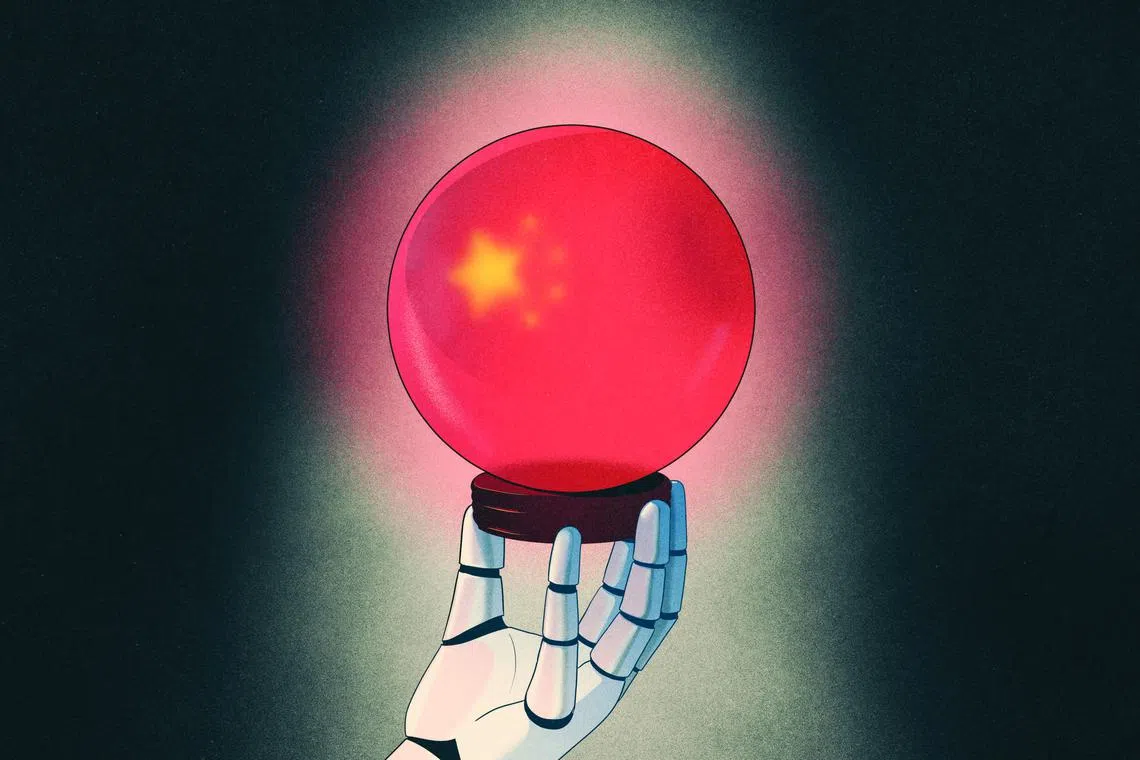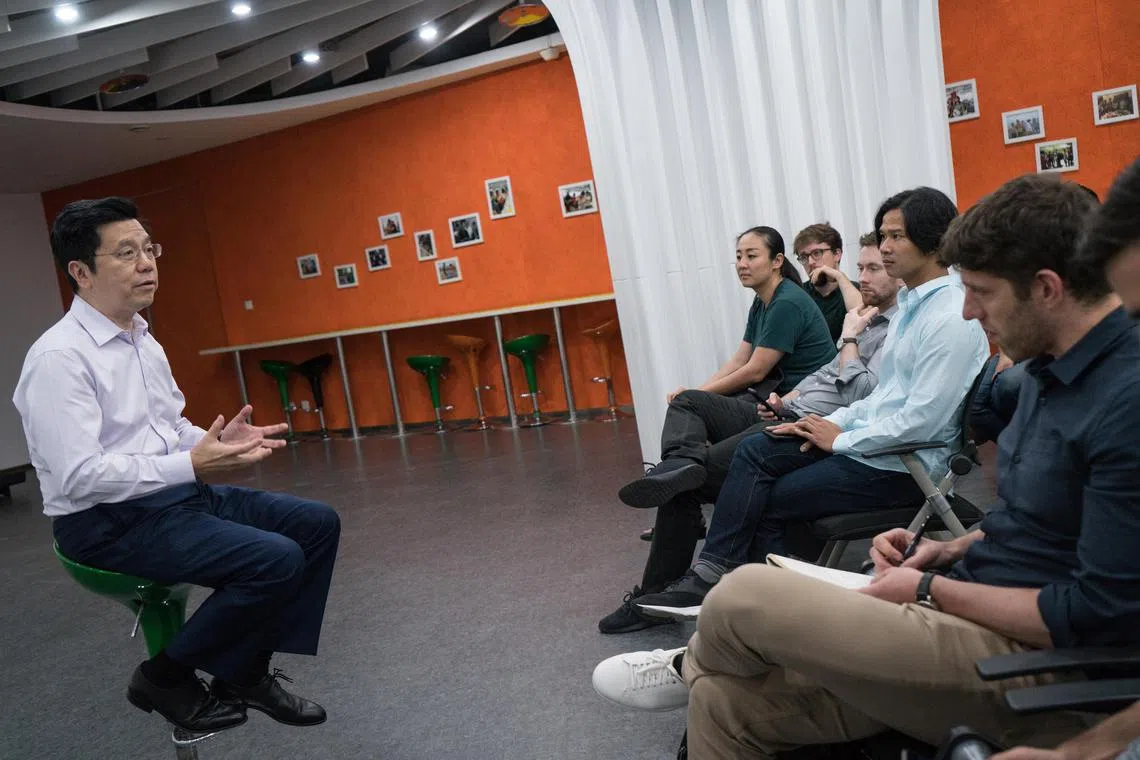China’s rush to dominate AI comes with a twist: It depends on US technology
Sign up now: Get ST's newsletters delivered to your inbox

As Chinese companies aim to catch up by turning to open-source AI models from the United States, Washington is in a difficult spot.
PHOTO: NYTIMES
Follow topic:
In November 2023, a year after ChatGPT’s release, a relatively unknown Chinese start-up leapt to the top of a leader board that judged the abilities of open-source artificial intelligence systems.
The Chinese company, 01.AI, was only eight months old, but had deep-pocketed backers, a US$1 billion (S$1.34 billion) valuation and was founded by well-known investor and technologist Lee Kai-Fu.
In interviews, Dr Lee presented his AI system as an alternative to options such as Meta’s generative AI model LLaMA.
There was just one twist: Some of the technology in 01.AI’s system came from LLaMA.
Dr Lee’s start-up then built on Meta’s technology, training its system with new data to make it more powerful.
The situation is emblematic of a reality that many in China openly admit.
Even as the country races to build generative AI, Chinese companies are relying almost entirely on underlying systems from the United States.
China now lags the US in generative AI by at least a year and may be falling further behind, according to more than a dozen tech industry insiders and leading engineers, setting the stage for a new phase in the cut-throat technological competition between the two nations that some have likened to a Cold War.
“Chinese companies are under tremendous pressure to keep abreast of US innovations,” said Mr Chris Nicholson, an investor with the venture capital firm Page One Ventures who focuses on AI technologies.
The release of ChatGPT was “yet another Sputnik moment that China felt it had to respond to”, referencing the 1957 launch of the Soviet satellite that led the US to subsequently pour resources into its own space programme.
Dr Jenny Xiao, a partner at Leonis Capital, an investment company that focuses on AI-powered companies, said the AI models that Chinese companies build from scratch “are not very good”, leading to many Chinese companies often using “fine-tuned versions of Western models”.
She estimated China was two to three years behind the US in generative AI developments.
The jockeying for AI primacy has huge implications. Breakthroughs in generative AI could tip the global technological balance of power, increasing people’s productivity, aiding industries and leading to future innovations, even as nations struggle with the technology’s risks.
As Chinese companies aim to catch up by turning to open-source AI models from the US, Washington is in a difficult spot.
Even as the US has tried to slow China’s advancements by limiting the sale of microchips and curbing investments, it has not held back the practice of openly releasing software to encourage its adoption.
For China, the new-found reliance on AI systems from the US – primarily LLaMA – has fuelled deeper questions about the country’s innovation model, which in recent decades surprised many by turning out world-beating companies such as Alibaba and ByteDance, despite China’s authoritarian controls.
“When Chinese companies are leveraging American open-source technologies to play catch-up, the questions become very complicated – wrapped up in issues of national security and geopolitics,” said Dr Oren Etzioni, a University of Washington professor who specialises in AI and founder of TrueMedia.org, a non-profit organisation working to identify disinformation online in political campaigns.
In an e-mailed statement, 01.AI’s Dr Lee said his start-up’s AI model was built on LLaMA just “like most other AI companies”, adding that using open-source technologies is a standard practice.
He said his company had trained its AI model from scratch, using its own data and algorithms.
Those were “the main determinants” of the “excellent performance” of 01.AI’s model, Dr Lee said.
Meta pointed to comments by its global affairs head Nick Clegg, in which he said that openly sharing the company’s AI models helped spread its values and standards, and in turn helped secure American leadership.
The New York Times has sued ChatGPT maker OpenAI and its partner Microsoft

In interviews, Dr Lee Kai-Fu (left) presented his AI system as an alternative to options such as Meta’s generative AI model LLaMA.
PHOTO: NYTIMES
AI has long been a priority in China. After the AI tool AlphaGo defeated two top players of the board game Go in 2016 and 2017, Chinese policymakers set out an ambitious plan to lead the world in technology by 2030.
The government pledged billions to researchers and companies focused on AI.
When OpenAI released ChatGPT in November 2022,
Chinese tech companies were also burdened by censorship rules designed to manage public opinion and mute major opposition to the Chinese Communist Party.
Chinese companies with the resources to build a generative AI model faced a dilemma.
If they created a chatbot that said the wrong thing, its makers would pay the price. And no one could be sure what might tumble out of a chatbot’s digital mouth.
“It’s just not possible to get rid of all the problematic ways these systems can express themselves,” said Dr Andrew Ng, who teaches computer science at Stanford University and was a former executive at Baidu, the Chinese search giant.
Chinese tech giants were also grappling with new regulations that dictate how AI models could be trained.
The rules limit the data sets that could be used to train AI models and the applications that were acceptable, and also set requirements for registering AI models with the government.
“It is both more difficult and more risky to innovate in generative AI in the current regulatory regime, which is still a moving target,” said Mr Kevin Xu, the US-based founder of Interconnected Capital, a hedge fund that invests in AI ventures.
Dr Chen Yiran, a professor of electrical and computer engineering at Duke University, said that tech investors in China have also pushed for quick turnarounds from AI, which has meant money has flowed to easy-to-execute applications instead of more ambitious goals focused on fundamental research.
As much as 50 per cent of China’s AI investment has gone into computer vision technology, which is required for surveillance, instead of building foundation models for generative AI, he said.
Now, Baidu, Alibaba, dairy company Mengniu and tutoring company TAL Education have all jumped into the generative AI race in China, leading Chinese media to coin the phrase “the battle of 100 models” to describe the frenzy.
Some have criticised the free-for-all as publicity stunts that add unnecessary competition.
In a panel discussion in 2023, Baidu chief executive Robin Li described having hundreds of basic AI models as a waste.
“More resources should be allocated to applications in various industries, especially considering the limitations on our computing power,” he said.
Success has been elusive. When Baidu introduced its chatbot, Ernie, in March 2023, the live demonstration was revealed to be pre-recorded. Baidu’s stock plummeted 10 per cent that day.
Despite the setback, Baidu remains one of China’s few major efforts at building a foundation AI model from scratch.
Others are being led by Alibaba and Tencent, China’s tech giants, as well as a start-up linked to Tsinghua University.
A Baidu spokesperson declined to comment.
US restrictions on AI chip sales to China pose further challenges, since many such chips are needed when training generative AI models.
Baidu and 01.AI, among others, said they have stockpiled enough chips to sustain their operations in the near future.
There are some bright spots for China with AI, including in fields such as computer vision and autonomous vehicles.
Some Chinese entrepreneurs are also looking to leapfrog the US with breakthroughs in other parts of generative AI.
Dr Wang Changhu, the former head of ByteDance’s AI lab, founded a company called AIsphere in Beijing in 2023 to spearhead what he saw as the next major frontier in the technology: video generation.
In November, the start-up released PixVerse, an AI-powered generator that can create video from a text description.
“We forged ahead, building our models from the ground up,” Dr Wang said. “This gives us a significant edge as true pioneers in the realm of video generation.”
That edge may have lasted just a few months.
Last week, OpenAI unveiled Sora, an AI tool that turns a simple text prompt into videos that look as if they were lifted from a Hollywood movie. Sora instantly went viral. NYTIMES

